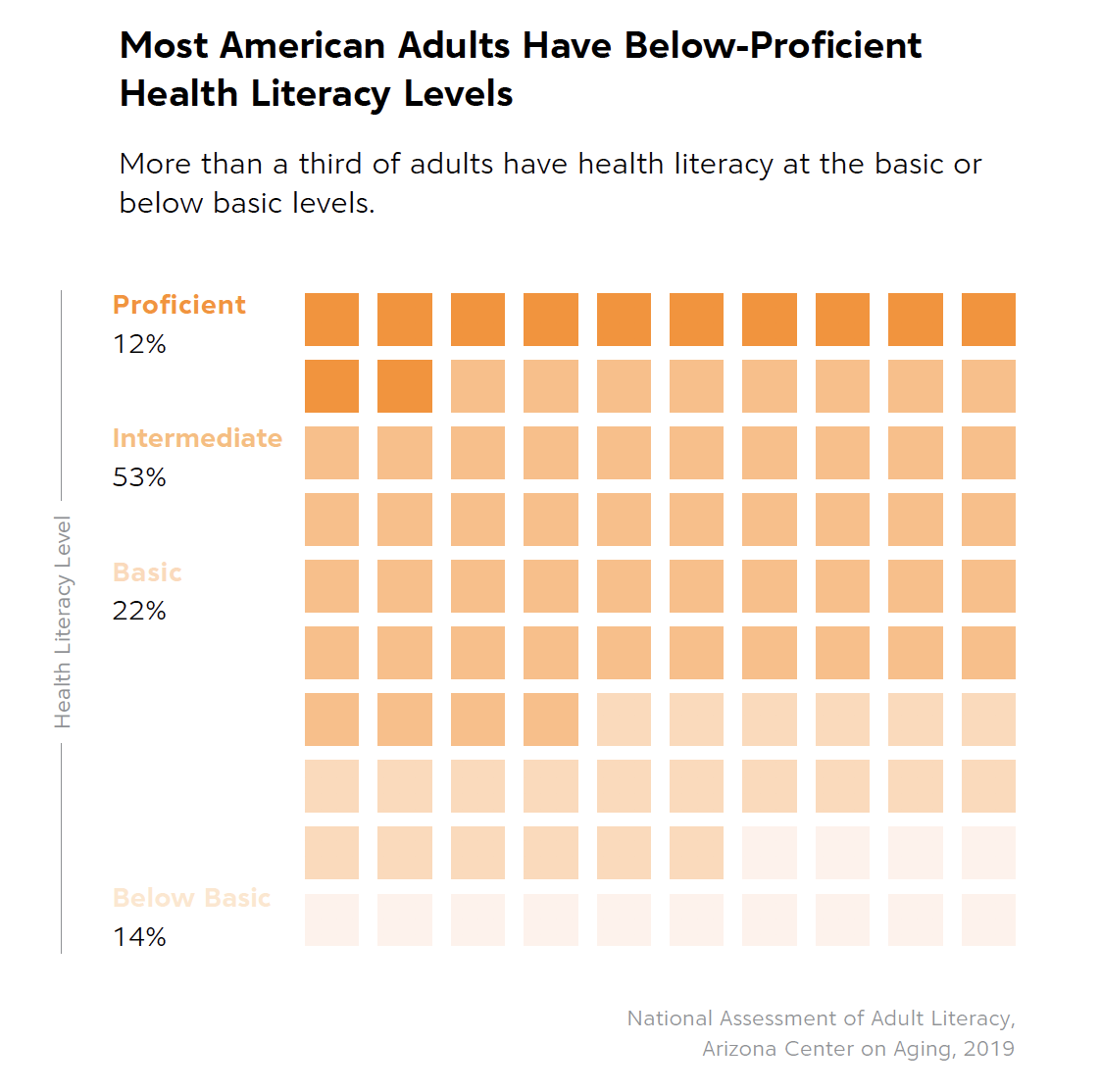Health Literacy’s Effect on Adherence Throughout the Patient Journey
Healthcare isn’t always accessible, and patients’ understanding of basic health information is an overlooked, but impactful barrier. This article looks at how technology can expedite the patient-education process by providing patient-specific, accessible information at critical junctures along the patient journey to medication adherence.

Patients often go into healthcare appointments with a few questions on their mind. After an average of 15 minutes with a provider and a flurry of new information, they can leave with more questions than they came in with, depending on how much they understood.
If one 2019 study is to be believed, it’s not much. Only 12 percent of adults have proficient health literacy.Health Literacy, Barry D. Weiss, MD, College of Medicine, University of Arizona, 2019 This confusion can compound as patients go on to interpret benefit details and medication information at the pharmacy counter.
The potential impact is immeasurable. Health literacy can affect a patient’s ability to make the right medication and healthcare choices, from understanding their diagnosis to taking a prescription correctly. Low levels of health literacy can make a life-and-death difference for patients. Studies have shown patients with low health literacy are 2.3 times more likely to visit the emergency room and have a higher mortality rate than those with proficient health literacy.Patients with low health literacy 2.3 times more likely to visit ED, Business Intelligence, 2017,Association between low functional health literacy and mortality in older adults: longitudinal cohort study, Bostock & Steptoe, 2012
For their part, providers are limited on time for education. Forty percent said they didn’t have enough time to discuss medications with their patients.CoverMyMeds Provider Survey, 2020 Though it’s not a panacea, technology can help in these circumstances by not only creating time-saving efficiencies but also surfacing patient-specific information to both fill the gaps in patient health literacy and improve adherence for better outcomes.
Below we examine three key stages of the patient journey to identify high-impact opportunities for provider-patient engagement as it relates to healthcare literacy.

Patient journey stage 1: Understanding the diagnosis and condition
Literacy in most any language improves with immersion. So the more patients can be involved in healthcare and medication decisions early on, the better they can advocate for themselves later. While provider time is sacred, the point of prescribing is ideal for educating patients early with information they can understand.
After all, there’s much to interpret between initial visit and prescription adherence, so starting patients off with a solid understanding of the diagnosis itself can get the patient journey off on a solid foundation.
Still, there are watchouts to note. When receiving complex details in a short time window, patients can be clouded by anxiety, confusion and even the symptoms they’re experiencing. Patients forget 40 to 80 percent of the information given by their providers — and of what they do remember, half is incorrect.Patients' memory for medical information, Kessels, 2003
While providers are short on time, they’re aware of the impact health literacy can have on a patient’s health outcomes.
As one internal medicine physician in our recent provider research noted:
“Healthcare literacy is one thing that truly hinders the wellness of my patient population. Resources spent on resolving this wide chasm between the medical world and the patients we serve would be a great achievement.”
Strategies such as having patients explain back a concept can improve provider-patient trust, and helps patients put complicated healthcare jargon into their own words.
Healthcare literacy is one thing that truly hinders the wellness of my patient population. Resources spent on resolving this wide chasm between the medical world and the patients we serve would be a great achievement.
Physician, Internal Medicine, Louisiana
In a recent HLTH webinar, Milisa Rizer, chief medical information officer at The Ohio State University Wexner Medical Center, said health literacy and communication are a key focus in their efforts for better patient outcomes.
“We’re doing a lot of work to educate patients and caregivers themselves to know what words to use to get the care they need,” Rizer said.
Technology can provide efficiency in patient education by not only surfacing condition-relevant information at the point of prescribing, but also through relevant data surfacing in patient portals. This way, once patients arrive home, they have an education support system to help process diagnoses and fill in missing information gaps.
When it comes to treatment options, care team solutions can surface patient-specific benefit information for medications. For more complex conditions, solutions also exist to alert providers of nearby clinical trials their patient may be eligible for.
When it comes to understanding the costs of managing care, patients face another literacy hurdle.
Patient journey stage 2: Interpreting insurance and benefit information
For the approximately 9 in 10 Americans who have health insurance, comprehension of how their plan works is important for cost expectations. In other words, patients who understand their benefits can better use them.
In a recent survey of 2,000 Americans, the following percentages correctly defined each term:
- Deductible: 50%
- Coinsurance: 22%
- Copay: 52%
- Out-of-pocket Maximum: 42%
- Only 4 percent surveyed could define all four terms.4 basic health insurance terms 96% of Americans don’t understand, Policygenius, 2018
Point-of-prescribing price transparency tools can not only provide a patient’s expected cost at the pharmacy but also surface helpful information such as remaining deductible and out-of-pocket maximum. This can help patients make the best affordability decision, especially when they have options such as drug manufacturer coupons and even cash price.
This transparency helps patients walk into the pharmacy with confidence on price – and can even prevent abandonment. Of the 66 percent of patients who found out a drug cost more than expected last year, 38 percent walked away without their medication.CoverMyMeds Patient Survey, 2020
Benefit transparency can also prevent waste and administrative burden for providers and pharmacists later on by avoiding medication switches and anticipating when a prior authorization might be needed.
A mail order pharmacy technician in our recent pharmacist survey noted the importance of patient-centric technology in improving the healthcare experience:
“Patients are always, always top priority so making a tool that's user friendly and doesn't require an advanced degree to interpret is pivotal,” they said. “Having access to all of the information in one place is also key. Having to go to multiple places just to find out what medications an insurance will cover is frustrating for professionals so I can only imagine how frustrating it is for patients.”
Having to go multiple places to find out what medications an insurance will cover is frustrating for professionals, so I can only imagine how frustrating it is for patients.
Pharmacy Technician, Mail Order, Arizona
Patient journey stage 3: Reading the pharmacy label and staying adherent
Diagnosis understood, prescription price settled, drug obtained and now to just take the medication. This should be the easy part. Unfortunately, that’s not always the case.
In one study, patients were given five medication bottles to interpret. The researcher found nearly half of patients misinterpreted at least one of the five prescription labels. Patients with low literacy were unable to grasp four out of five label instructions.Study Finds Many Patients Don't Understand Prescription Medicine Labels, Northwestern University, 2006 In most cases, patients could read the words on the label, but interpreting them was a different story. This task gets more complicated when patients take multiple prescriptions daily.
Pharma manufacturers can help with dosage and administration instructions by providing digital and print medication information at the provider’s office as well as within EHRs and patient portals for easy access.
A trusting relationship with the pharmacist can also help patients who not only may need help interpreting a prescription, but also understanding management of multiple prescriptions. Nearly 74 percent of pharmacists said patients regularly ask them about medication information, and 70 percent said medication information, including dosing and interactions, would exist in their ideal tool.CoverMyMeds Pharmacist Survey, 2020
Healthcare comprehension and health literacy can make a measurable impact on patient outcomes. While patients are top priority for providers and pharmacists, they are often strapped for the time they need to have meaningful conversations with patients that improve understanding. Technology can not only save time to allow these conversations to happen more often, but also provide a wealth of patient-specific knowledge to improve health literacy.
Read more about health literacy as it relates to healthcare consumerism with Kathy’s story in the 2021 Medication Access Report.
The latest healthcare insights, floated right to your inbox.



